With manga perhaps more than anime, I’m often initially drawn in by the artwork. If the story doesn’t engage me, no manga is beautiful enough to keep me reading for all that long. This one, though, would be damn close even if the story weren’t interesting and well-crafted – but fortunately, it is.
Otoyomegatari (A Bride’s Story) is the work of Kaoru Mori. She’s best known for her Victorian set-piece Emma, which was adapted into a popular anime. She writes doujins, too, under a pseudonym, but until this new series it’s stories set in England that she’s known for. She sticks with historical romance here, but with a decidedly different twist in both setting and theme.
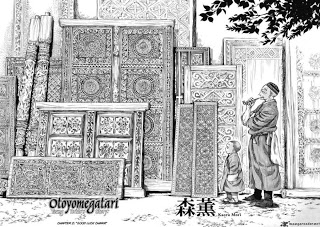 Mori has a spectacular hand with both backgrounds and characters – every panel is richly detailed, each face is distinct and vibrant. While Emma showed her dexterity with man-made landscapes, Otoyomegatari reveals that she’s no less adept with scenes of nature. The setting this time – while never explicitly stated (yet) is somewhere in the mountains near the Caspian Sea. The characters – bar one – are Turkic peoples of the late 19th Century, mostly nomadic. It follows the lives of one extended family, the young woman who marries into it, and the British anthropologist staying with them to learn their culture.
Mori has a spectacular hand with both backgrounds and characters – every panel is richly detailed, each face is distinct and vibrant. While Emma showed her dexterity with man-made landscapes, Otoyomegatari reveals that she’s no less adept with scenes of nature. The setting this time – while never explicitly stated (yet) is somewhere in the mountains near the Caspian Sea. The characters – bar one – are Turkic peoples of the late 19th Century, mostly nomadic. It follows the lives of one extended family, the young woman who marries into it, and the British anthropologist staying with them to learn their culture.
That’s where things get a bit edgy, though. The “Bride” of the title is Amira – a 20 year-old woman considered beyond prime marriage age because she’s likely to bear fewer children than a younger bride. And her husband is 12 year-old Karluk, youngest of his family. While it was unusual for a groom to be younger than his bride even then, people did marry younger – though that isn’t likely to assuage readers uncomfortable with the premise.
All I can say to that is: don’t be. What could in lesser hands have been titillating or distasteful is here charming, even heartwarming. Mori doesn’t ignore the obvious awkwardness of the age difference, but she treats it respectfully and humorously. The relationship, naturally, starts out almost as a sibling one – with Amira being quite protective and patient with Karluk. He’s quite mature and responsible for his age, and immediately takes it upon himself to be a true husband to Amira – in most ways. He fulfills his duties with the extended family, he’s solicitous of Amira’s feelings – but obviously uncomfortable with some aspects what is expected of a husband. Amira is shown to be a tough, smart and resourceful woman – a skilled rider, hunter and cook.
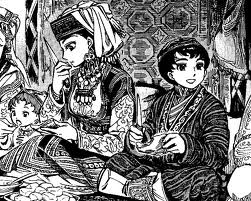 The relationship really works because of how likeable both these characters are, and because Mori allows their bond to grow at a natural pace. When Karluk becomes ill, Amira falls into a panic and dutifully obsesses over him, although it’s a simple cold. When Amira’s family comes to renege on the marriage contract when a better offer comes along, Karluk stands up to grown men to physically defend her. Karluk reminds me of Chagum from Seirei no Moribito in some ways – in his gentle nobility of character, his curiosity and intelligence, his kindness. With each trial and new adventure they grow closer, even sharing a kiss, but Mori doesn’t exploit that side of their relationship for cheap entertainment. Where that side of the story goes, who can say – but for now we’re watching the two of them come to love each other, and that’s the point.
The relationship really works because of how likeable both these characters are, and because Mori allows their bond to grow at a natural pace. When Karluk becomes ill, Amira falls into a panic and dutifully obsesses over him, although it’s a simple cold. When Amira’s family comes to renege on the marriage contract when a better offer comes along, Karluk stands up to grown men to physically defend her. Karluk reminds me of Chagum from Seirei no Moribito in some ways – in his gentle nobility of character, his curiosity and intelligence, his kindness. With each trial and new adventure they grow closer, even sharing a kiss, but Mori doesn’t exploit that side of their relationship for cheap entertainment. Where that side of the story goes, who can say – but for now we’re watching the two of them come to love each other, and that’s the point.
There are side stories involving the rest of Karluk’s family – his little cousins, his siblings, parents and grandparents, and others in his village. The major supporting character though is Henry Smith, the English researcher. In many ways he acts as the audience’s proxy – learning about the nomadic culture at the same time the reader does. He does get involved in the plot itself beyond the observer role, even getting his own romantic story – full of travel, danger and forbidden love – that’s still ongoing at the close of the second volume. In some ways Smith is a pretty stereotypical Japanese take on a 19th Century British academic – bespectacled, blonde, nerdy-looking and awkward, though kind. But he shows true mettle when he needs to, and a surprising insight into the culture he’s studying. He’s a solid character.
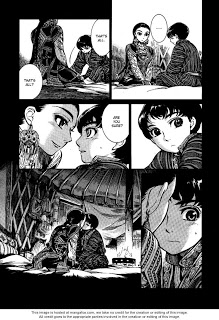 The manga is originally published in the seinen magazine “fellows!”, and licensed by Yen Press in America with the first volume released and the second due in October. They’ve chosen to release it in hardcover, interestingly – a rare thing for manga indeed. It does gloriously show off the author’s stunning artwork, and it’s a first-rate printing all around. I hope the cost doesn’t scare off some potential readers – but there’s no denying it’s an eye-catching package.
The manga is originally published in the seinen magazine “fellows!”, and licensed by Yen Press in America with the first volume released and the second due in October. They’ve chosen to release it in hardcover, interestingly – a rare thing for manga indeed. It does gloriously show off the author’s stunning artwork, and it’s a first-rate printing all around. I hope the cost doesn’t scare off some potential readers – but there’s no denying it’s an eye-catching package.
This may be a series that has a hard time finding a niche in the English fan community, where seinen manga is hardly a powerhouse commercially. I hope not – this is a beautiful manga, both visually and dramatically. I think you’d be hard-pressed to find more impressive art in any mainstream manga, and for me the setting and characters are completely winning. This is not well-trodden ground for the medium, and it’s clear Mori – as always – has done her homework. Her depiction of the Turkic culture is fascinating, and I think the central relationship – despite only being “romantic” in a very innocent way for now – is completely charming and believable. This is my favorite new manga of 2011 so far.



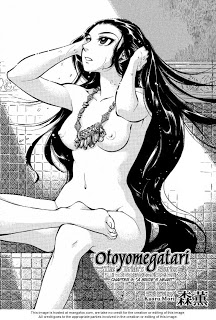

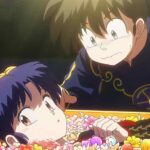
Eric J.S.
June 16, 2011 at 4:21 amYeah, I own the hardcover manga already. I long been a fan of the manga, but I finally have an official English copy. Like you, what really grabs me is the artwork. My other interest is the way the author will integrate the complicated political happenings around the time the manga is set (I have written a good bit this year for my cultural studies on Northern Africa and America's perceptions of Islam).
admin
June 16, 2011 at 4:40 amI get the sense that the current arc with Smith is going to more overtly touch on the political side of things than the earlier arcs in Karluk's village did.
Like I said – with manga art can draw me in, but the characters and story have to be good to be keep me. No question, this art is stupendous – but I love the rest of it almost as much.
Arabesque
June 16, 2011 at 10:39 pmI got my copy about a while ago and I must say, Yen Press is officially my favorite manga publisher. The quality of the release is miles ahead of CMX's Emma release (and despite how grateful I was for them releasing the manga in full as well as the Shirley volume, the quality of the paper was just inappropriate for Kaoru Mori's beautiful artwork)
The main draw in here, as you had pointed out, that Kaoru Mori is drawing it, so naturally it is fantastic looking, but again much like you had written, the story itself is quite interesting as well. I never got worried about the age thing, mainly due to having myself being something history and knew that these sort of marriages were more or less common practice at that time era, and to be honest I personal found out that this angle gives a lot of good story potential.
The other thing that drew me in was how well researched this was, much like Emma had been. The Arabesque Chapter in particular (:P) was an interesting look into the craftsmanship of the art, and the relationship dynamics of the family and how they each treated each other does show that Ms. Kaoru had spent a lot of time studying about tribal habits and culture back in the 19th century.
And much like Emma, there is a whole lot of scenery p0rn, both with items unique to that time, and the gorgeous scenery.
Also, I'm sure you might've seen this already, but seeing the master at work is always worth a re-post
http://www.youtube.com/watch?v=wfENoePp36o&feature=related (6-parts of her drawing one smashing picture)
''though that isn't likely to assuage readers uncomfortable with the premise.''
or it could attract trolls unfortunately (just look at ANN)
I hope people don't get turned away from this title, due to how good it is, and it only gets better and better from here on out, with the story taking some good turns and we learn more and more about the life back then